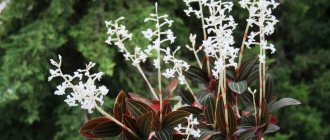What are the beneficial properties of cardamom?
The plant is rich in B vitamins, ascorbic acid, and rutin. It contains trace elements, minerals, proteins, thiamine. It improves body tone and prevents illness. I drink a drink with cardamom for prevention:
- flu;
- colds;
- cough;
- diabetes
For me, growing rosemary and elettaria in my apartment is a way not only to create an aesthetic corner, but also a source of healthy products.
I use cardamom oil as an antiseptic to help with sore throats and fungal infections. For pulmonary diseases, it helps improve expectoration.
Water procedures with cardamom oil help to calm down. By adding it to food I eliminate heartburn.
Growing by cuttings
Cuttings can only be taken from an adult plant. Ideal length of shoots: 7-10 cm. To do this, cut off the apical shoots of cardamom and place them in a jar of water or wet sand. In order for the cuttings to take root faster, the cutting sites are treated with a growth accelerator solution.
After the roots appear, the standard procedure for planting the plant in a pot follows.
Cuts on the rhizomes are treated with crushed activated carbon so that they do not rot.
Cardamom varieties for growing on a windowsill
Biologists call cardamom eletharia. This genus includes only one species - Eletaria cardamomum.
| Variety | Type | Origin | Suitable for growing on a windowsill? | Fruit price | Aroma |
| Malabar | Green | South India | Yes | Dearest | Strong camphor |
| Ethiopian | Black | Africa | Yes | Average | Camphor smoky |
| Korarima | Black | Africa | Yes | Average | Coffee |
| Melagusta | Black | Liberia | Yes | Average | Black pepper |
| Javanese | Black | India | Yes | Average | Camphor smoky |
| Chinese | Black | China | Yes | Average | Camphor smoky |
| Bengal | Black | India | Yes | Average | Camphor smoky |
All black and green types are suitable for growing at home.
To learn how spices grow in nature, watch the following video:
Types and varieties
Although cardamoms come in a variety of colors, the commonly used varieties are black and green.
Black cardamom (Amomum) comes in the following types:
- Amomum siamese is usually used in landscape design.
- Amomum sabulatum (Nepali) is distinguished by leaves that resemble a stabbing instrument. The grains have a pungent taste and a faint smoky odor.
- Amomum shaggy (sharen). The fuzzy seeds smell like menthol. Popular in Chinese medicine.
Green cardamom (real) is represented by two types: Malabar and Ceylon. The fruits of the first type are smaller in size, but the gastronomic features are significantly superior. Its spices are the most popular and expensive in the world; their fiery taste will add piquancy to any dish.
White cardamom is a bleached green, but the grains are not spicy and have a milder taste.
Ethiopian - grows in Madagascar and African countries. This is similar to black cardamom, but is of low quality.
There are other varieties that are used only in the place where they grow: Chinese, Javanese, melagusta and others.
What you need to grow cardamom from seeds
To create an exotic green corner, you need high-quality planting material. Also needed:
- air humidification system;
- container for planting;
- acidic soil.
Choosing the optimal place in the house
The culture needs warmth and moisture. In order for the seeds to germinate, the room must be heated to 28 degrees or higher. To maintain stable humidity, I cover the container with cardamom with film.
This creates an optimal microclimate. Some gardeners joke that cardamom germination is no more difficult than storing and growing horseradish. I described how to do this in another article, enjoy reading!
Cardamom can be grown in a greenhouse or at home
Selection and preparation of containers
A regular flower pot will do. I fill it with soil and water it. I place no more than 2 seeds in one container.
Soil selection
The optimal soil for cardamom is acidic (about 5.5-6 units). You can make such soil yourself. I prefer ready-made mixtures from the store.
For cardamom to grow well, you need soil enriched with humus, not humus.
Creating the necessary conditions: lighting, air humidity, temperature
Cardamom requires moderate, regular watering. I moisten the soil in the evening by spraying liquid from a spray bottle over the sprouts. When there is excess moisture, the rhizomes begin to rot. In winter, I reduce the frequency of watering several times.
In summer, cardamom grows well in warm conditions. In winter, when the holiday season begins, the normal temperature is 15 degrees.
Should you plant cardamom in winter?
Of course not!
The culture suffers in a draft. I don’t put the pot in a ventilated place, otherwise the specimen will quickly die.
The optimal frequency of feeding is once every 3 weeks during the active growth season.
I replant an adult plant every year. On average, a seedling takes root within a week.
Knowing the necessary conditions for cardamom, try growing a bay leaf on the window! Care is not much different, but it’s nice to always have a fresh product on hand).
Seed preparation
The best planting material is large seeds. Do not purchase seed pods - it is impossible to judge the quality by their appearance.
Cardamom seeds ripen in bean-like pods
Sowing rules
Sequencing:
- I check the acidity of the soil.
- I prepare the furrows for the seeds.
- I'm sowing.
- I knead the soil with my hands and sprinkle the seeds with it.
- I moisten with a spray bottle.
- Cover with film.
- I put it in a warm place.
The sowing depth is twice the width of the seed.
Every day I remove the film for a quarter of an hour to prevent the appearance of mold.
By the way, this is not the only tropical crop that can be planted. Not long ago I told you how to grow bamboo. Trust my experience - it goes great with cardamom!
Seedling care
The average germination time of seeded material is 35-55 days. I remove the polyethylene when the plants reach 15-20 cm. You can replace the film with a bottle (plastic, glass).
Under natural conditions, cardamom grows in the tropics. The normal level of air heating is up to 35 degrees Celsius. In order for seedlings to develop quickly, a humid, hot climate is necessary. The minimum air temperature is 28 degrees.
I moisturize the shoots daily. No feeding required.
Author's note
Natalia Papanova
Blog author
Sprouts need diffused light. The plant naturally grows in conditions of average sunny day, so it needs lighting less than 14 hours a day.
When to replant seedlings
I replant cardamom when the seedlings grow. A height of about 20 cm is considered sufficient. For seating, I take wide, shallow containers.
Cardamom seeds sprout 1-2 months after sowing
Cardamom transplantation, containers and substrate
Elettaria is similar to bamboos not only in appearance, but also in its very fast, aggressive growth. With normal care, the plant completely masters the container within a year, so regardless of age, indoor cardamom is replanted annually.
For elettaria, wide containers are used, the depth of which is less than the diameter. The wider and lower the bowl, the better. It is advisable to provide the plant with large holes for water drainage.
The substrate for cardamom is selected from among simple, universal soils with good water and air permeability. You can use a purchased substrate (universal or for ornamental foliage plants) or make your own soil from humus and turf soil with sand (ratio 2 to 2 and 1, respectively).
The procedure itself is standard. Elettaria is not afraid of contact with roots, but if possible, it is better to carry out the transplantation procedure as carefully as possible. A high layer of drainage is laid at the bottom. The soil is compacted as little as possible. After transplantation, the plant is shaded for several days, and air humidity is increased if possible.
Caring for cardamom at home
Fellow gardeners, the crop develops quickly and does not get sick if adequate conditions are provided. To do this, I organize warming up, air humidity, and regularly add additives to the soil. In nature, specimens grow in the tropics, so they cannot tolerate cooling below 10 degrees Celsius. Cardamom is a perennial seasonal plant that needs rest.
Illumination
Young shoots develop well in diffused light. Adult culture needs bright, diffused lighting. In the summer, I install a shadow source above the specimen so that direct sunlight does not harm it. In winter, I organize additional lighting sources, since in conditions of too short daylight hours the plant becomes weaker and gets sick.
Temperature
Cardamom is a heat-loving crop. In summer, air heating of about 25-28 degrees is required. The specimen can withstand heat up to 35 degrees without any problems.
Winter time is the rest season. I choose a cool place for the flower, making sure that the temperature does not exceed 15 degrees.
Air humidity
Cardamom is a tropical crop that naturally grows in humid environments. To provide the necessary comfort to the flower, I spray the bush daily with a spray bottle. I have a shower once a week. If this is not possible, I remove dust and dirt from the green parts with a damp soft sponge.
Cardamom does not tolerate dry air very well and gets sick. To protect the plant I use the preparation “Zircon”.
For growth, development, flowering, cardamom needs warmth and moisture.
How to water
During the warm season, cardamom needs water. Regular daily watering is required. I make sure that the soil is moistened evenly and that the liquid does not stagnate.
In the cold season, I reduce the frequency of watering, making sure that the soil does not dry out completely. The average frequency of watering in winter is once every 2 weeks or a little more often.
I use pre-settled water. Optimal heating is 16-18 degrees.
Top dressing
I feed the crop in spring and summer - this activates growth. For the first time, I enrich the soil 2 months after transplantation, since before that the soil contains a sufficient amount of nutritional compounds for the development of the bush. The best fertilizer is a mixture for vegetables made from minerals and organic matter. I do not use compounds with nitrogen - they are harmful.
The optimal frequency of feeding in summer is once every 3 weeks.
Experts talk about the difference between organic and mineral fertilizers in the following video:
Features of transplantation
I start by choosing a suitable container - shallow, wide. At the bottom I make a layer of drainage. I fill the pot with ready-made acidic soil or a mixture of turf and humus, sand (the last ingredient is half as much as the first two).
When is a cardamom transplant needed?
The culture, like lemon balm, suitable for indoor growing, grows and develops quickly. I replant the bush every year.
Cardamom grows quickly, so it needs regular replanting.
Features of flower pruning
I organize pruning in the spring - in March, April. The event is necessary to form the crown. Rules:
- I remove the side trunk to activate the growth of the “false” one.
- I save 2 buds on the shoot to form a bush.
- I remove parts of the plant that break the symmetry and stick out to the sides.
- I thin out opposite branches that interfere with each other.
- I pinch the top.
Content Rules
The houseplant does not have high care requirements. Perfect for people who love to travel, because the flower tolerates short-term droughts well. Natural habitat - tropics.
Despite its unpretentious nature, certain conditions still need to be created at home.
Lighting. If the cardamom was purchased in a store, you should first clarify in what conditions the plant was kept before and continue the same care. It mainly prefers diffused light.
Air temperature. Ideally, the growing season should be accompanied by warmth: 20-25 degrees. During dormancy, on the contrary, reduce it to 12-15, otherwise the plant will lose the ability to bloom and will not allow the harvest of seeds in the future.
Another important factor is how to water the flower correctly. Elettaria tolerates waterlogging worse than drought. As soon as cold weather sets in and daylight hours decrease, irrigation must be reduced.
High air humidity is maintained with a special humidifier. Another option is frequent spraying with water.
Apply fertilizing regularly throughout the growing season. Use universal products or special ones for potted vegetable crops.
Transplantation should be carried out annually, because cardamom grows very quickly. The container should be wide and low. The soil is universal, loose, or you can make it yourself: humus, sand, turf. Be sure to put a drainage layer on the bottom, do not compact the soil. After transplanting, create partial shade for a couple of days and increase air humidity.
Cardamom propagation
Friends, the main methods of propagating the crop are by seed, dividing the roots and separating from apical cuttings. Since cardamom belongs to the ginger family, the second option is the best option.
| Reproduction method | Seeds | Dividing the roots | Cuttings |
| Complexity | Minimum | Average | Minimum |
| Germination rate | Minimum | Maximum | Average |
| Probability of germination | Average | Maximum | Average |
| Time until reaching fertile age | Maximum | Minimum | Average |
By dividing the rhizome
I carry out this procedure when replanting, thoroughly shaking off the soil. I make sure that the selected specimen has 2 buds and 2 active roots. After separation, I disinfect the wounds with activated carbon, then immediately place them in previously prepared soil.
A healthy, large bush is suitable for division.
You cannot plant a young specimen in already used soil: it contains no nutrients and the plant will not be able to develop.
Properly diluted cardamom blooms already in the 3rd year
Seeds
To grow cardamom from seeds at home, I place the seed at a depth twice the width of the seed. I sprinkle the surface with substrate, spray it generously from a spray bottle, and cover it with polyethylene and glass. For germination, a temperature of about 28 degrees Celsius is required. Sprouts need diffused good lighting.
By cuttings
The material for the procedure is cuttings obtained from an adult bush. Size – up to 10 cm. I cut specimens with a sharp, disinfected knife; the wound is immediately treated with ash and activated carbon. Quick treatment will prevent the area from rotting.
In order for the cuttings to take root, it is necessary to maintain adequate temperature conditions - not lower than 20 degrees. The roots will grow faster if the cut is treated with boric and succinic acid. You can put the cuttings in water. As soon as the root system appears, I plant the specimen in a container with acidic soil and water it abundantly.
Main characteristics of the plant
Cardamom is an evergreen perennial. It belongs to the Ginger family because it has a fleshy root system. In its natural environment, the flower grows in Sri Lanka, India, Tanzania and Madagascar. Despite its tropical origins and where cardamom grows in nature, it is successfully grown on a windowsill.
The peculiarity of the plant is its fleshy roots and two types of stems. One of them is called false. It quickly reaches to the top and foliage grows on it. The other escape is considered real. There are no leaf blades on it, but during the flowering period buds appear, collected in thick brushes.
If you take a closer look at how cardamom grows, you will notice successive leaves located on thin petioles. The length of the plate reaches 60 cm, the width is about 8. If the leaf is slightly kneaded, it emits a pleasant aroma, for which it is very much appreciated. And when buds appear on the shoot, their colors are simply amazing. One of the snow-white petals has a patterned purple base, which is located in the center of the bud. The remaining petals are colored green. This combination causes unprecedented delight among lovers of greenery.
When the flowering period ends, fruits appear in the form of small boxes. Each of them stores a lot of seeds, which are used for plant propagation and as a spice in cooking.
When choosing a permanent place for a plant in the house, you should take into account the amount of diffused light. At the same time, the flower does not like direct sunlight. In critical situations, it is necessary to create an artificial shadow over the plant.
Diseases and pests
Culture is threatened:
- viruses;
- scale insect;
- mite.
Root rot is possible if the soil is over-moistened. Lack of moisture leads to yellowing of the foliage. Sometimes waterlogging is manifested by a brown border of leaves.
Have you ever had cardamom pain?
Not really
Spider mites appear as thin webs. With severe infection, the bush loses its greenery and growth slows down. To cure a specimen, I use Fitoverm and Actellik. You can irradiate the plant weekly for 2 minutes with ultraviolet light.
Scale insects and false scale insects appear as sticky drops on the greenery. With severe infection, the leaves dry out and fall off. I treat the bush with Fufanon and Fitoverm.
You can see about the use of Fitoverm here:
Preparing cardamom for planting
The spice loves warmth and scattered rays of the sun. It will feel good on a southern window sill, in a glazed balcony, loggia. In winter, growth slows down, but the plant still needs light. A draft-free window sill is suitable for winter.
Do not plant near heating pipes - the leaves will dry out and the plant may die. The culture requires space; you should not take up the space around it with other colors.
When planting, seeds do not require pre-treatment. The only condition is that they must be freshly harvested; germination rate drops very quickly.
Harvesting and storage
Dear plant growers, both when growing ginger (read about this in another article) and when breeding elettaria, one of my main goals is to obtain a harvest.
Cardamom bears fruit in bean-shaped pods filled with green, yellow round grains. The average seed diameter is 4 mm. The spicy smell is appreciated. The bush bears fruit from the age of three.
Flowering occurs in the first three months of the calendar year. I have been collecting seeds since October. The fruits ripen unevenly, making harvesting difficult. The optimal time for removal is shortly before ripeness, since mature seeds spill out of the pods.
I dry the pods in the oven. It is better to store the boxes and grind the required amount of beans immediately before use. If you chop the entire crop at once, it will quickly lose its flavor.
I store the spice in a tightly closed jar at a temperature of no more than 25 degrees Celsius.
Keep cardamom unground and preserve the spice longer.
FAQ
Natalia Papanova
Blog author
Ask your question
Friends, many people know tropical culture only from store shelves with spices, so there are many questions related to its growth, cultivation and use.
What are the contraindications for consuming cardamom?
Cardamom is beneficial when used wisely. Excess spice leads to stomach pain. Do not eat the product if you have: • allergies; • individual intolerance; • gastritis; • stomach ulcer; • hypertension. Cardamom is contraindicated for pregnant women and people suffering from chronic stomach, intestinal, and liver diseases.
How is cardamom used in cooking?
The fruits of the plant are added to drinks and main dishes. They are combined with: • pepper; • cumin; • cinnamon sticks. When cooking, I add the seasoning immediately, because it takes time for the flavor to develop. I remove the seeds after cooking. In sweets, fermented milk comes fresh ground cardamom. The plant's greens are ideal for salads. I include the seeds in marinades for vegetables and fish, and use them in cheeses and canned food. Cardamom is a traditional ingredient in German gingerbread and Scandinavian sausages. In Russia they prepare Easter cakes with it.
Why is cardamom added to alcoholic drinks?
Adding cardamom to alcohol removes the characteristic unpleasant odor from the drink and enriches the taste.
The video explains the benefits of drinks with cardamom:
general description
Cardamom is a plant from the Ginger family, growing from 1.5 to 3 m in height. This aromatic spice is native to the evergreen forests of the southern Indian state of Kerala and is grown in several tropical countries.
The leaves are spear-shaped and can grow up to 70 cm in length. The stems are stiff and straight, forming an inverted skirt around the plant. The flowers are tiny but beautiful: white, yellow or red. Different types of cardamom can produce black, white or red fruits (pods).
The pods are tripartite, with a thin but tough outer covering. Inside is the source of the aroma - tiny, dark brown seeds arranged in vertical rows. Each grain is inside a thin transparent membrane.
Types of cardamom
The main type is green cardamom (Elettaria, also known as real cardamom). Used in sweet and savory dishes. It has a thin, almost transparent, green pod filled with small blackish seeds.
This type is the most popular for both culinary and medicinal use.
Less common is black cardamom (Amomum, also known as brown, kravan, Bengal or Siamese). It has a large, thick, rough, black-brown pod filled with black seeds. Has a slightly smoky smell.
Most often, ground or green cardamom is found on store shelves. Another type is considered less healthy and not as fragrant.
In medicine
Products containing cardamom are used to treat various diseases, most often colds and ARVI. The easiest way to get rid of sore throat, weakness and fever is to drink a glass of milk with some seasoning added to the tip of a knife. For genitourinary diseases and digestive tract disorders, the spice can be added to any dish. Drinking green tea with a pinch of cardamom and a slice of lemon in the morning will improve your body tone and freshen your breath.
Cardamom is a spice with unique properties and medicinal properties, which, if used correctly, will become the housewife's best friend. It will help in the difficult task of preparing culinary masterpieces, preserving youth and maintaining the health of household members.
Contraindications for use and possible harm to health
Cardamom should not be perceived as a completely harmless spice.
Cardamom should not be consumed for the following conditions and diseases:
- Pregnancy.
- Lactation period.
- Disruption of the gallbladder.
- Peptic ulcer, gastritis due to increased acidity of gastric juice.
- Hypertonic disease.
- Young children.
- Individual intolerance.
Cooking recipes with cardamom
A wide variety of dishes and drinks are prepared with the addition of cardamom.
Tea
To brew tea you will need:
- 250 ml water;
- 250 ml milk;
- 2 tablespoons of black tea;
- 5 pieces of cardamom;
- 1 cm ginger root;
- sugar at your discretion.
Cooking method:
- Pour water into a saucepan, add milk, put on fire and bring to a boil.
- As soon as the liquid boils, reduce the heat, add black tea, ginger and cardamom.
- Cook for another 5 minutes over low heat, then strain.
Next, you can add sugar to your liking.
Coffee
Coffee with cardamom is very aromatic and tasty. To prepare you will need:
- 100 ml water;
- 2 cardamom seeds;
- 2 teaspoons ground coffee;
- sugar to your taste.
Method of preparing the drink:
- Pour coffee, sugar, crushed cardamom spice seeds into a Turk.
- Pour in cold water and place on the stove over low heat.
- Remove the Turk from the stove as soon as a small white film forms on the surface.
- Let the drink stand for 5 minutes, then return to the fire.
- Repeat the procedure 2 more times. At the same time, make sure that the coffee does not boil.
- Remove from heat for the last time, let sit for a few minutes, then drink.
Often cinnamon, lemon slices and other ingredients are added to coffee along with cardamom. Therefore, it is possible to find your favorite option for preparing this drink.
Mango lassi
To prepare the drink you will need:
- 400 g canned mango;
- 350 g low-fat yogurt;
- a quarter teaspoon of ground cardamom.
To enjoy this unusual drink, you need to place all the ingredients in a blender and blend. Next, pour into cups and place mint leaves on top.
Thus, cardamom is a plant widely used in cooking as a spice. But culture can not only improve the taste of dishes, but also have a positive effect on human health.
How to choose and where to buy
Both seeds and ground cardamom are sold in the spice section of supermarkets, while whole pods are available in specialty stores.
When purchasing cardamom, choose green cardamom as it has a complex flavor that suits both sweet and savory dishes.
It is better to choose whole cardamom pods, or rather cardamom pods, rather than ground spices. The greener they are, the better the aroma.
Cardamom is an expensive spice, but most of the cost comes from long-distance transportation and intermediary services. If you do not want to overpay, buy it in the international online store IHerb.
Chemical composition and nutritional value
The seeds of the plant contain 3-8% essential oil containing fatty oil, cineole, protein, terpineol and terpinyl acetate [2].
The seeds also contain dietary fiber, vitamins, potassium, calcium, magnesium, phosphorus, iron, manganese and zinc. The energy value of the spice is 311 kcal per 100 grams. Nutritional value per 100 grams (approximately) [3]
| Nutrient | Quantity | Average daily intake for an adult |
| Calorie content | 331kcal | 1684kcal |
| Squirrels | 10.8 g | 76 g |
| Fats | 6.7 g | 60 g |
| Carbohydrates | 40.5 g | 211 g |
| Alimentary fiber | 28 g | 20 g |
| Water | 8.3 g | 2400 g |
| Ash | 5.8 g | – |
| Vitamin B1 | 0.2 mg | 1.5 mg |
| Vitamin B2 | 0.18 mg | 1.8 mg |
| Vitamin B6 | 0.23 mg | 2 mg |
| Vitamin C | 21 mg | 90 mg |
| Vitamin PP | 1.1 mg | 20 mg |
| Potassium | 1120 mg | 2500 mg |
| Calcium | 380 mg | 1000 mg |
| Magnesium | 230 mg | 400 mg |
| Sodium | 18 mg | 1300 mg |
| Phosphorus | 180 mg | 800 mg |
| Iron | 14 mg | 18 mg |
| Manganese | 28 mg | 2 mg |
| Copper | 383 mcg | 1000 mcg |
| Zinc | 7.5 mg | 12 mg |
| Omega-3 | 0.12 g | 0.9-3.7 g |
| Omega-6 | 0.31 g | 4.7-16.8 g |
Why is it useful?
The beneficial properties of cardamom help improve health and prevent many diseases:
- Treats coughs and colds thanks to its antioxidant properties. The pods are steeped in water along with honey and this cardamom tea is drunk as an effective natural remedy for flu.
- Helps digestion. The strong aroma activates the sense of taste and improves appetite.
- Prevents Bad Breath: Cardamom's floral and sweet aroma makes it a natural breath freshener.
- Regulates blood sugar levels thanks to its high manganese content.
- Promotes weight loss: Cardamom increases energy metabolism and helps the body burn more fat.
- Improves Blood Circulation: It increases blood circulation in your body, especially in the lungs and is therefore often used as a treatment for respiratory problems.
- Treats sleep problems: Inhaling the sweet and soothing aroma of cardamom essential oil can help with insomnia.











